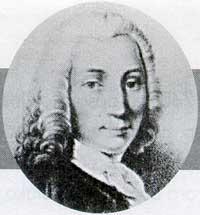Fahrenheit, Gabriel Daniel
1995/08/02 Azkune Mendia, Iñaki - Elhuyar Fundazioa | Kaltzada, Pili - Elhuyar Zientziaren Komunikazioa
(1686-1736)
German physicist born in Dantzig (present-day Gdansk of Poland) on 14 May 1686. Still young, he emigrated to Amsterdam to study business, despite being a manufacturer of meteorological devices.
Until then the invented thermometers were not accurate. Thermometers with liquid were already in use. It can be liquid, alcohol, its mixtures and water. But these thermometers were not very good either, since by boiling the alcohol at low temperature, it did not measure high temperatures. Mixtures of alcohol and water were better in the mentioned problem, but their volume was variable according to the different temperatures.
In 1714 Fahrenheit discovered that it replaced alcohol with mercury. In practice he could also test on the thermometer, but first he had to find the method of cleaning the mercury to prevent it from sticking to the thin tube of the thermometer. With mercury, both high and low temperatures could be measured. In addition, mercury was dilated and contracting more uniformly, so the thermometer scale could be divided into smaller units. Newton suggested in 1701 to divide the interval between the freezing point and the normal temperature of the human body into twelve equal parts. Fahrenheit, however, mixed salt to the water so that its freezing point was lower. This point was valued at 0. He then distributed the difference between this point and normal body temperature in 96 "degrees." That is why the thermometer was so accurate. He then reconditioned the thermometer with the boiling point at 212 degrees and the freezing point at 32 degrees. On the Fahrenheit scale, the temperature of the human body is 98.6 degrees.
It was the first accurate thermometer. Fahrenheit discovered that the boiling point of water was constant. He also experimented with other fluids and found that in normal conditions each liquid had its boiling point. He also found that the boiling point varied depending on the pressure.
The Fahrenheit scale is currently used in Britain, the United States, Canada, South Africa and New Zealand. Elsewhere a scale invented by Celsius is used a quarter of a century later. The relationship between both scales is as follows:
ºF = [(9/5) ºC] + 32.
Fahrenheit died on 16 September 1736 in The Hague (Holland).

Gai honi buruzko eduki gehiago
Elhuyarrek garatutako teknologia






